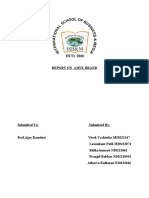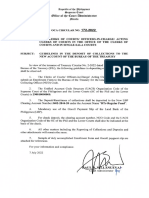Alp en Lie Be
Alp en Lie Be
Uploaded by
Jaber HussainCopyright:
Available Formats
Alp en Lie Be
Alp en Lie Be
Uploaded by
Jaber HussainCopyright
Available Formats
Share this document
Did you find this document useful?
Is this content inappropriate?
Copyright:
Available Formats
Alp en Lie Be
Alp en Lie Be
Uploaded by
Jaber HussainCopyright:
Available Formats
Alpenliebe
Introduction: Alpenliebe, a hard-boiled sugar candy, was one of the first brands to be launched after Perfetti Van Melle (India) Ltd. (PVMI) launched its operations in India in 1994.
A wholly-owned subsidiary of the world's third largest confectionery major Perfetti Van Melle S.p.A, PVMI also had other big brands such as Center Fresh, Center Shock, Big Babol, Chlormint, Mentos, Fruitella, Cofitos, Protex Happydent, Happydent White, Marbles, Chocoliebe, Chatar Patar, etc., in its brand portfolio. As of early 2008, Alpenliebe was the single largest selling sugar confectionery brand in India and made up a major portion of PVMI's revenue, estimated to be Rs.7 billion in 2007.
Market Strategy: 1. Naming: Alpenliebe is a difficult name to adopt for a chocolate and much research on the internet couldnt help me trace out its origin. So it is a Herculean task to teach Indians ( with 24 languages and a million dialects) pronounce a brand name that does not have a meaning. Theory says that the brand name should be simple, reflect the brand values and easily pronounced. Alpenliebe broke all rules. In the initial 30 second ad of Alpenliebe pronounced the name 5 times to ensure that the TG pronounce it correctly. Why such a complicated brand name is another question all together. But this risk paid off in that the name became the biggest differentiator and reflected an International image. It is known fact that Indians are crazy about foreign brands and Alpenliebe capitalised on that.
2. Shape: The shape was also unique because most of the candies at that time was rectangular or cylindrical but Alpenliebe came out with a round shape. More than the shape and the name, the product itself was good .The company changed the taste of this brand to suit the Indian Palette making it more creamier and filled with more caramel than the international one. 3. Flavours: Alpenliebe was available in three flavors - 'rich milky caramel', 'cream strawberry', and 'chocolate'. In addition to this, the company also started marketing lollipops under the Alpenliebe brand in the early 2000s in three flavors - 'rich milky caramel', 'strawberry cream', and 'cola & vanilla'. In 2005, the company also launched a center-filled candy under the brand name Abpenliebe Creamfills. The Confectionery Market: The sugar confectionery market includes products such as sweets, jellies, and gums but not chocolate confectionery. While there was a large unorganized market for sugar confectioneries in India, the organized market in India was estimated to be US$461 million in 2007, i.e., around 70 percent of the total candy market in the country. According to Euromonitor, the market in India grew at a rate of 7.2 percent per year between 2003 and 2008.The market was dominated by PVMI, which was the market leader with a market share of more than 30 percent, Cadbury India, Wrigley's, and Lotte Confectionery.
Other significant players in the market were Hindustan Unilever Ltd (HUL), ITC Ltd (ITC), Nestl India Ltd., Candico, Godrej Beverages and Food Ltd., and Ravalgaon Sugar Farm Ltd.Analysts felt that the market was witnessing a shift with an expansion in the organized segment. In the early 2000s, the competition in the Indian sugar confectionery industry intensified. Fast moving consumer goods (FMCG) majors such as ITC and HUL too entered the fray.
In 2004, Lotte India consolidated its position by acquiring a controlling stake in one of the leading Indian confectionery companies, Parry, while Wrigley's acquired the worldwide operations of Joyco gum and confectionery businesses from Agrolimen and further consolidated its position in the Indian market where Joyco held a strong position. All these companies were devising aggressive marketing programs to corner a bigger share of the market. The sugar confectionery market in India was pricesensitive and distribution driven.
It was driven by children who spent a significant portion of their pocket money on sugar confectioneries and, as such, most of the brands were available at low price points such as Rs.0.50 and Rs.1.00. Stiff competition in the market had also ensured that the pricing was constant for nearly five years. Unlike in other countries, mono packs ruled the Indian sugar confectionery market. And a very big chunk of the sales came from unorganized mom-and-pop stores and the paan shops. Moreover, unlike in more developed markets, most of the functional and sugar-free products were yet to catch on. Marketing Confectionery in India and Alpenliebe: The companies competing in this market relied heavily on advertising, sales promotion (both consumer and trade), and the distribution network. They were trying to reposition the brands to appeal to the whole family rather than children alone and to expand the price points with value added products.
Analysts felt that PVMI had played a great role in developing the market in India. For instance, it was credited with creating the Indian caramelized candy segment in India with Alpenliebe.It did this by offering a quality product at the Rs.0.50 price point and backing it up with a smart advertising and distribution strategy.
The brand was positioned as an irresistible offering with the pay-off line-cumjingle, Jee Lalchaye Raha Na Jaaye. Considering that the brand name was somewhat complicated for the Indian audience, the initial 30 second ads for the brand pronounced the name five times to ensure that the target audience got familiar with it and pronounced it properly.
By 2002, Alpenliebe was estimated to be a more than Rs.1 billion brand in India and accounted for one-third of PVMI's revenues.
Alpenliebe variants: PVMI also kept the brand interesting to the target audience by launching new variants such as 'cream strawberry' in 2003 and 'Chocoduet' in 2007. It was a relatively late entrant in the lollipop segment. In the lollipop market that was declining (14 percent in 2002) and dominated by two brands Pim Pom of Joyco and Mr Pop of Cadburys with a market share of 70 percent and 30 percent respectively, PVMI managed to emerge as a leader in 2003 with a market share of 46 percent.
According to analysts, it had snatched the market leadership in the lollipop category by moving away from the kid-centric positioning of lollipops. The brand, marketed at the Rs.2.00 price point, was also targeted at adults while emphasizing the long-lasting properties of its lollipops in the initial ads, and then following it up with the immensely popular colloquial advertising with the pay-off line Lagey Raho (Keep going!).
Alpenliebe Creamfills, which the company had developed for the Indian market, and promoted with the pay-off line Kuch alag Achanak (Something different, Suddenly!), too did exceptionally well and was also launched in other markets including China and Poland.
Celebrity Endorsement: In 2006, the sales of Alpenliebe in India were estimated to be Rs. 1.6 billion. It was not only PVMI's biggest brand but also the biggest brand in the Indian sugar confectionery market.In the following year, PVMI roped in leading Hindi film actor Kajol for promoting Alpenliebe.
Analysts considered this a big shift considering that this was the first time that PVMI was using celebrity endorsement for any of its brands. However, Sameer Suneja was quick to point out that the script called for Kajol's presence and that it would help take Alpenliebe, which was already a big brand, to the next level.
The new pay-off line Laalach Aha Laplap was used, which promoted the message that when a person takes Alpenliebe once, the desire and greed for the candy increases.
The ad campaign, created by McCann India, showed how a crocodile (animated) accidentally tastes an Alpenliebe and follows Kajol around for more.
The launch of the Alpenliebe Chocoduet was also supported by a similar ad featuring Kajol and the animated crocodile.
In early 2008, Alpenliebe was also involved in co-branding with popular Indian actor Ajay Devgan's (Devgan) film You Me Aur Hum. Devgan, also Kajol's husband, appeared in the ad promoting the movie and the brand. Analysts felt that the concept of Alpenliebe had been beautifully integrated with the movie scenes and the theme.
With its latest ad campaigns, PVMI was trying to increase the market share of Alpenliebe further in the growing sugar confectionery market in India.
Conclusions: According to analysts, the sugar confectionery market in India was expected to grow at a compound annual growth rate of 8 percent through 2011, primarily due to increased consumption by affluent consumers who tended to purchase sugar confectionery on impulse, the retail revolution in India, and increase in the pocket money of children. But some experts were not altogether satisfied with PVMI's decision to use celebrity endorsement for Alpenliebe, and particularly its decision to go in for a theme built around an animated crocodile. They felt that though the new ads scored high on attention and recall, the company risked diluting the brand image of Alpenliebe by venturing into the realms of 'absurdism'. What is to be seen is the way in which Alpenliebe would move to increase its market share in this intensely competitive and restricted market.
This was the Case history behind Alpenliebe and now we come down what I think about the brand and the opportunities it has in the future: Challenges faced were: 1. Fixed price points and inability to manipulate with them 2. The characteristic of chocolates being an impulsive purchase 3. A stable competitor Coffee Bite in the confectionery segment 4. New brand name Strategies well executed:
1. PVMI deserves credit for creating a big brand (Alpenliebe) in the low value, low margin, and fragmented sugar confectionery market in India that was quite different from the market in other developed countries but very competitive nevertheless. 2. Ever introduction of new flavours and hence adapting to the consumer 3. Initial commercial repeated the brand name about 6 times to get the pronunciation right 4. Positioning of Alpenliebe as a fun and family brand 5. Effective marketing and distribution strategies 6. Introduction of mono and multi packs at price points of 0.50Rs, 1Re and 5 Rs. What can be done in the future? 1. Alpenliebe should maintain its positioning as a family toffee rather than focussing on the celebrity promotion campaign. Most of the TG felt that the celebrity endorsement was not in sync with the core positioning of Alpenliebe. 2. Have Alpenliebe mono and multi packs at the display counters next to the cash at the retail marts. Even though this is strategy is being followed this shelf space in any retail mart is dominated by Cadburys. Alpenliebe should focus more on having its 5Rs packs at this shelf. 3. Alpenliebe could introduce family packs with varied assortments 4. Most of Alpenliebe sales come from the Kirana stores and hence it should focus on having a sound distribution strategy for these stores.
You might also like
- Parle GDocument21 pagesParle GAshu Salian50% (8)
- Business Plan On CandiesDocument17 pagesBusiness Plan On Candiesy2krohan78% (9)
- CASE METHODOLOGY - ColgateDocument11 pagesCASE METHODOLOGY - ColgateFakhrul Anour AbdullahNo ratings yet
- Amul Case MRDocument1 pageAmul Case MRbhartic0% (2)
- Proposal For RelaunchDocument9 pagesProposal For RelaunchM Tanzeel Rahman KhanNo ratings yet
- Global Brand Power: Leveraging Branding for Long-Term GrowthFrom EverandGlobal Brand Power: Leveraging Branding for Long-Term GrowthRating: 5 out of 5 stars5/5 (1)
- Market StrategyDocument9 pagesMarket StrategyMohammad AsgharNo ratings yet
- Promotion MixDocument12 pagesPromotion MixsumitmaxguptaNo ratings yet
- Alp en Lie BeDocument10 pagesAlp en Lie BevimalnandiNo ratings yet
- PerfettiDocument20 pagesPerfettiAparna Monga100% (1)
- PVM ProfileDocument14 pagesPVM Profilepallavilive_in10No ratings yet
- Amm Presentation-120811224207-Phpapp01Document28 pagesAmm Presentation-120811224207-Phpapp01irfankhan007No ratings yet
- Report On Amul BrandDocument34 pagesReport On Amul BrandVivek VashisthaNo ratings yet
- BM 18046 PVMDocument6 pagesBM 18046 PVMPrabhat GuptaNo ratings yet
- PVM Product ProfileDocument3 pagesPVM Product ProfileJaison InbarajNo ratings yet
- Product Analysis of ChocolateDocument21 pagesProduct Analysis of ChocolateSamhita Bardhan100% (1)
- Perfettivan Melle IndiaDocument4 pagesPerfettivan Melle IndiaMeenakshi KolayNo ratings yet
- CADBURY Case StudyDocument1 pageCADBURY Case StudySomdeep SenNo ratings yet
- Life Cycle of Cadbury Dairy Milk: 1.1 Company ProfileDocument13 pagesLife Cycle of Cadbury Dairy Milk: 1.1 Company Profilearun chandrasekarNo ratings yet
- Strategic MarketingDocument31 pagesStrategic MarketingKhurram RajputNo ratings yet
- CadburyDocument58 pagesCadburyShashi Kant SoniNo ratings yet
- Cadbury Dairy Milk and Its CampaignsDocument14 pagesCadbury Dairy Milk and Its Campaignsmridul.basnetNo ratings yet
- CadburyDocument43 pagesCadburyBabasab Patil (Karrisatte)No ratings yet
- Perfetti Van MelleDocument19 pagesPerfetti Van MelleAnkit JainNo ratings yet
- Submitted By: Submitted To:: Perfetti Van MelleDocument20 pagesSubmitted By: Submitted To:: Perfetti Van MelleSakshi Agarwal100% (2)
- Relaunch of Good MilkDocument9 pagesRelaunch of Good MilkSehrish HudaNo ratings yet
- Oreo in IndiaDocument14 pagesOreo in IndiaMahak Gupta Student, Jaipuria LucknowNo ratings yet
- Cadbury CompetitorsDocument3 pagesCadbury CompetitorsSadaf Iqbal100% (1)
- Kraft Acquisition of CadburyDocument10 pagesKraft Acquisition of CadburyManal VermaNo ratings yet
- Brand Audit of CadburyDocument38 pagesBrand Audit of CadburyChandan Pahelwani100% (4)
- Erfetti Van Melle: Project On STOP NOTDocument19 pagesErfetti Van Melle: Project On STOP NOTMDNo ratings yet
- The Indian Chocolate Market Can Be Sliced Into Four PartsDocument9 pagesThe Indian Chocolate Market Can Be Sliced Into Four PartsAnkur SavadikarNo ratings yet
- Cad BuryDocument2 pagesCad BuryAnuj SachdevNo ratings yet
- Marketing Strategies in India of Colgate PalmoliveDocument8 pagesMarketing Strategies in India of Colgate PalmoliveriteshbhatnagarNo ratings yet
- GopalDocument37 pagesGopalBHARATNo ratings yet
- Project Report On Cadbury: Brand Positioning & RepositioningDocument35 pagesProject Report On Cadbury: Brand Positioning & RepositioningsnehaldoddamaniNo ratings yet
- Marketing CIA Marketing MixDocument6 pagesMarketing CIA Marketing MixSANCHAYNo ratings yet
- OlpersDocument31 pagesOlpersNabil Toor0% (1)
- Key FactsDocument5 pagesKey FactsseesawupndownNo ratings yet
- Cadbury - Stage 2Document13 pagesCadbury - Stage 2Saajan RathodNo ratings yet
- Cadbury Dairy MilkDocument47 pagesCadbury Dairy MilkShivani GargNo ratings yet
- IntroductionDocument3 pagesIntroductionMohamad Ismail AmbiahNo ratings yet
- Perfetti'S Distribution Strategy: A Case StudyDocument22 pagesPerfetti'S Distribution Strategy: A Case StudyShashi Ranjan KumarNo ratings yet
- Consumer Behaviour: Group ProjectDocument5 pagesConsumer Behaviour: Group ProjectAanchal MahajanNo ratings yet
- Olpers Case EditedDocument10 pagesOlpers Case EditedStrikerKnightsNo ratings yet
- Cadbury Main Project - Final Joel 35 PgsDocument27 pagesCadbury Main Project - Final Joel 35 PgsJoel D'souzaNo ratings yet
- Fairness CreamDocument19 pagesFairness Creamcoolrohit0522100% (3)
- Amul 2Document56 pagesAmul 2ujwaljaiswalNo ratings yet
- Brand Positioning & Repositioning: Case Study: SABENA' Belgium World AirlinesDocument8 pagesBrand Positioning & Repositioning: Case Study: SABENA' Belgium World AirlinesNitinNo ratings yet
- Anaysis of AdvertisementsDocument21 pagesAnaysis of AdvertisementsbenusagardubeyNo ratings yet
- Synopsis of Nestle Vs Cadbury Anil Mohit 7376335919Document17 pagesSynopsis of Nestle Vs Cadbury Anil Mohit 7376335919AnilNo ratings yet
- Amul PPTDocument25 pagesAmul PPTVivek VashisthaNo ratings yet
- Parle Mango Bite Rough Info.Document7 pagesParle Mango Bite Rough Info.Pooja Bhatia100% (1)
- Advertising & Media Audit On Thums UpDocument6 pagesAdvertising & Media Audit On Thums UpK KEERTHAN REDDYNo ratings yet
- Korean Beauty Secrets: A Practical Guide to Cutting-Edge Skincare & MakeupFrom EverandKorean Beauty Secrets: A Practical Guide to Cutting-Edge Skincare & MakeupRating: 2.5 out of 5 stars2.5/5 (4)
- Small Biz Trio: Three eGuides for Marketing Success: 123 eGuides, #5From EverandSmall Biz Trio: Three eGuides for Marketing Success: 123 eGuides, #5No ratings yet
- Building Brand Equity: The Importance, Examples & How to Measure ItFrom EverandBuilding Brand Equity: The Importance, Examples & How to Measure ItNo ratings yet
- These Zian HoudaDocument531 pagesThese Zian Houdayoussefriifi100% (1)
- OCA Circular No. 172-2022Document3 pagesOCA Circular No. 172-2022Arnel CaparrosNo ratings yet
- Lec 03 - Islamic Law of ContractDocument30 pagesLec 03 - Islamic Law of ContractSonia KhanNo ratings yet
- Rubric PDFDocument1 pageRubric PDFKevin John BarrunNo ratings yet
- Services Marketing Project On DHL PakistanDocument59 pagesServices Marketing Project On DHL PakistanNazish Sohail91% (11)
- 1992 Report On The Construction of The Grafton BridgeDocument92 pages1992 Report On The Construction of The Grafton BridgeAdam CarrollNo ratings yet
- Law On Evidence: Atty. Rushid Jay S. SanconDocument51 pagesLaw On Evidence: Atty. Rushid Jay S. SanconRushid Jay Samortin SanconNo ratings yet
- Section 313 NewDocument7 pagesSection 313 Newmohit kumarNo ratings yet
- Owens v. State (Brief)Document2 pagesOwens v. State (Brief)Sawyer LikeNo ratings yet
- Minutes For Grade 2 Strawberry Parent Orientation: Call To OrderDocument4 pagesMinutes For Grade 2 Strawberry Parent Orientation: Call To OrderEvelyn DEL ROSARIONo ratings yet
- TinhLaSoiTo TrishThuyTrangDoanPhi BBM PDFDocument1 pageTinhLaSoiTo TrishThuyTrangDoanPhi BBM PDFthongit2512No ratings yet
- Chapter 3 - Quiz EnglishDocument1 pageChapter 3 - Quiz EnglishFitri-ssiNo ratings yet
- Duplichecker Plagiarism ReportDocument4 pagesDuplichecker Plagiarism ReportJinal JinalNo ratings yet
- Highlights of ADR Act KPLDocument2 pagesHighlights of ADR Act KPLAgonay ChannasNo ratings yet
- Funskool: Team Simark SimsreeDocument17 pagesFunskool: Team Simark SimsreeAkash BhangareNo ratings yet
- Rules With Friends and FamilyDocument4 pagesRules With Friends and Familyeasylearning83No ratings yet
- Wheel of Fortune and Piers PlowmanDocument8 pagesWheel of Fortune and Piers PlowmanSüleyman ÖzcanNo ratings yet
- Electronic Reservation Slip (ERS) : 6225990670 12331/himgiri Express Ac 2 Tier Sleeper (2A)Document3 pagesElectronic Reservation Slip (ERS) : 6225990670 12331/himgiri Express Ac 2 Tier Sleeper (2A)iampriyam127No ratings yet
- Which Occult Authorbook Has Taught You The MostDocument6 pagesWhich Occult Authorbook Has Taught You The MostMike Cedersköld75% (4)
- 12th Quarterly Report For Oakland NSADocument85 pages12th Quarterly Report For Oakland NSAali_winstonNo ratings yet
- CIR vs. Lianga Bay LoggingDocument4 pagesCIR vs. Lianga Bay LoggingMidori SanNo ratings yet
- 41768.0121862269fullpaper - Ayush Jaiswal & Ayushi SrivastavaDocument9 pages41768.0121862269fullpaper - Ayush Jaiswal & Ayushi SrivastavaAyush Raj0% (1)
- Micro Screening Result ChartDocument1 pageMicro Screening Result ChartRV RecazaNo ratings yet
- J 6 D2 DBSD WHOe RPu 2Document1 pageJ 6 D2 DBSD WHOe RPu 2Madhur GuptaNo ratings yet
- Montenegro Vs COADocument13 pagesMontenegro Vs COAFacio BoniNo ratings yet
- AML+Compliance+in+Practice+ +Suspicious+Activity+Reports+ +slidesDocument99 pagesAML+Compliance+in+Practice+ +Suspicious+Activity+Reports+ +slidesHayNo ratings yet
- Aashish Application FormDocument11 pagesAashish Application FormAshish AshuNo ratings yet
- Cyberbullying: Parents and Teachers' Perceptions and Awareness in The Light of Covid-19 PandemicDocument4 pagesCyberbullying: Parents and Teachers' Perceptions and Awareness in The Light of Covid-19 PandemicDaniel BrownNo ratings yet
- Understanding of KPIs (Autosaved)Document35 pagesUnderstanding of KPIs (Autosaved)Ayman TamimNo ratings yet
- Henry Ford's Model of Mass ProductionDocument8 pagesHenry Ford's Model of Mass ProductionSidhesh GaneriwalaNo ratings yet

























































































